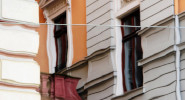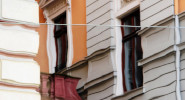
Bauhaus University Weimar
Key figures
Background
Originally established in 1860 as The Great Ducal Saxon Art School, the Bauhaus University Weimar is not only a distinguished historic center of learning, but also home to two important historic buildings. One of these is the Van-de-Velde Building, which is now a UNESCO World Cultural Heritage site. However, like the Bauhaus.Atelier, it was altered and reconstructed at various points during the 20th century. In preparation for the University’s 150th anniversary in 2010, a restoration project was launched to return these two buildings to their original historical layout and appearance.

Task
The two buildings are over a century old, but are examples of two different architectural styles, which resulted in two different sets of demands for the glass required for their restoration. As well as remaining faithful to their historic styles, the glazing had to meet modern-day construction standards. For the Van-de-Velde Building, a UNESCO World Cultural Heritage site dating back to 1906, the insulated glass panels needed to be much thinner than usual to fit into the historic frames. The Atelier, meanwhile, had to emulate the original ornate patchwork of panes with irregular angles and surfaces.Solution
SCHOTT’s specialist restoration glass TIKANA® was chosen for the Van-de-Velde Building, as its irregular surface structure closely resembled the style of early 20th-century glass. Sun-protection coating was then added, along with an interior float glass panel that featured a thermal insulation coating. A different glass laminate was developed for the Bauhaus.Atelier, which combined SCHOTT RESTOVER® restoration glass on the exterior – featuring a distinctive wavy surface in keeping with 19th-century glazing – and extra-clear float glass on the interior to prevent unwanted tints.A highly customized solution
For the glazing solution for the Van-de-Velde Building, the space between the TIKANA® panels and secondary insulating float glass panels was reduced from 16 mm to 4 mm, before being filled with the noble gas krypton to increase the level of insulation further. For the Bauhaus.Atelier, the panels of RESTOVER® glass and extra-clear, low-iron float glass were joined by overlapping PVB foils to enhance mechanical security and significantly reduce levels of UV transmission to offer protection from harmful solar radiation and make the glazing more durable.Enhancing the flow of natural light
The SCHOTT TIKANA® glass used for the Van-de-Velde building enhances the natural light flow into the entrance area – something that was traditionally a defining feature of the building. Working alongside architects Junk & Reich, who arranged to remove partitions and false ceilings in order to restore the building’s original layout, more light was allowed into the building. In the Bauhaus.Atelier, light was again harnessed more effectively, with the relative lack of harsh reflections achieved by RESTOVER® glass resulting in a clearer view through the building’s windows and a cleaner look for this historic structure.Used materials & similar products
SCHOTT RESTOVER® and TIKANA® provide a number of key advantages for restoration projects, as they offer highly authentic historic glazing characteristics while also meeting modern quality standards for insulation and security. SCHOTT manufactures its restoration glass using the traditional Fourcault process for historical accuracy.Expert collaboration for historical excellence
SCHOTT’s renowned expertise in developing glass for restoration projects made us the ideal partner for the Bauhaus University project. The project involved close collaboration with architects Junk & Reich and Pitz & Hoh throughout the restoration, ensuring that the glazing achieved the best possible combination of authenticity and practicality.Glass made by
SCHOTT
Architects
Junk & Reich, Pitz & Hoh









